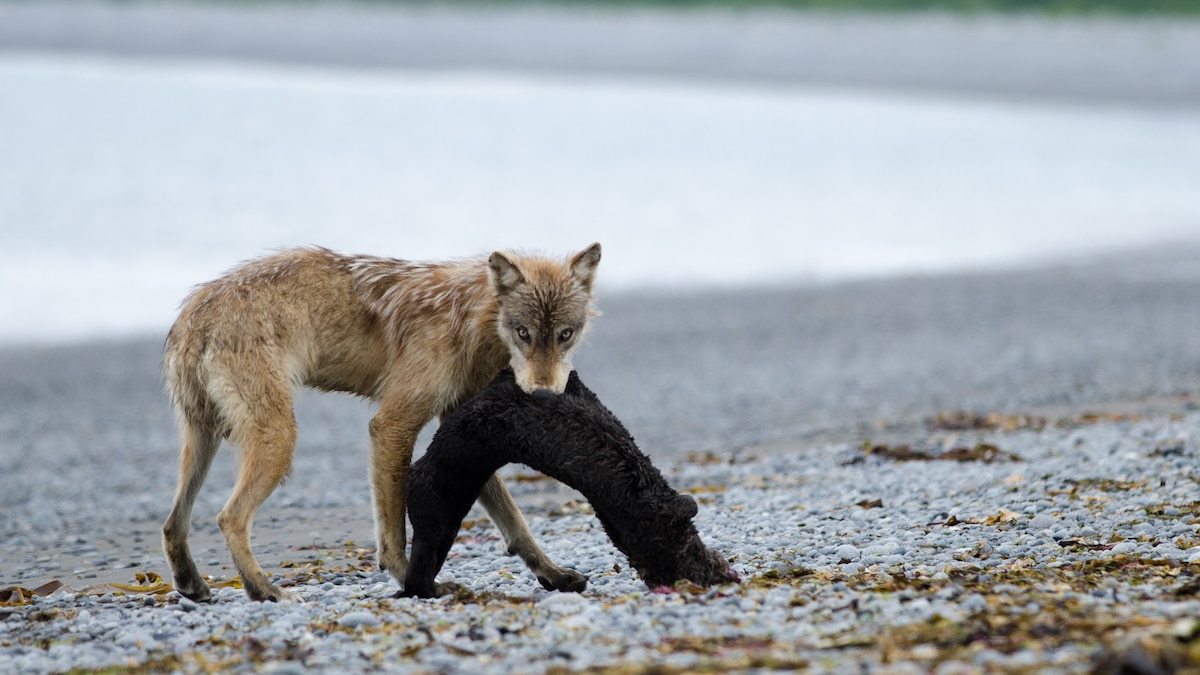
Patrolling the beach on Alaska’s remote Katmai coast, the white wolf came to the mouth of a creek, where freshwater fed into the salty Hallo Bay.
After about a minute, the predator suddenly lunged forward into the water, clamping its powerful jaws around the tail of a harbor seal—a large-bodied marine mammal that can weigh more than twice as much as an adult wolf.
With a mighty pull, the wolf dragged the seal onto a sandbar, and for the next half hour, the seal futilely snapped at its captor as the wolf continued to tear into its tail. Once the seal died, the wolf trotted away, only to return with a packmate. Together, they devoured their prize.
This scene, filmed by a group of biologists in Katmai National Park and Preserve in 2016, is the first time a wolf has been documented hunting and killing a marine mammal. Then, in 2021, they witnessed their first sea otter hunt: A nursing female and two male packmates dispatched an adult sea otter resting on a rocky outcropping.
The findings, published in October in the journal Ecology, are significant because it’s a departure from what wolves are famous for—hunting hooved animals such as deer and elk, wearing down their prey with relentless endurance and cooperative pack tactics. This Katmai study fits into a growing collection of research suggests that wolves are more flexible than previously believed, munching on everything from beavers to salmon. (Meet the rare swimming wolves that eat seafood.)
“The biggest takeaway is just thinking about wolves as not strictly terrestrial predators, but that they can influence different ecosystems, and in this case, coastal ecosystems and they’re potentially an important linkage between terrestrial and marine systems, says Kelsey Griffin, a biologist with the National Park Service and lead author of the paper.
Ambush and a meal
The Katmai coast, with its glacier-lined fjords; vast meadows; and wide, sandy beaches, is beautiful—and incredibly remote. Griffin had to be airlifted in with her research team.
While the cold and constant drizzle, as well as numerous storms, may be unwelcoming to humans, Katmai teems with wildlife. The annual Fat Bear Week competition, hosted by Katmai National Park, takes place each summer in creeks overflowing with sockeye salmon. And in recent decades, rebounding populations of sea otters and harbor seals have returned to their old home range in the thousands.
Previous studies had found evidence that wolves in Alaska and British Columbia eat local marine life—scat samples contained genetic material from seals, sea otters, and even sea lions. Wolves are opportunistic scavengers and won’t turn up their nose at a carcass, but the frequency with which seafood appeared in the scat samples suggested it’s “a strategy they’ve adopted,” says study co-author Ellen Dymit, a Ph.D. student in wildlife science at Oregon State University. Several packs chose den sites extremely close to the beach, she says.
But since no one had ever seen a wolf kill a harbor seal or sea otter, the researchers began a beach stakeout, setting up both camera traps and literally sitting there with cameras in hand. They caught the seal hunt through pure luck—Griffin recalls they were watching grizzlies forage nearby when they spotted the white wolf.
To capture a sea otter hunt, Griffin and her team concentrated their efforts on times the tide was lowest—when otters would have the least water to maneuver, and the wolves would be better able to access the string of small intertidal islands. (Wolves are competent swimmers—like a dignified doggy paddle, Griffin says.)
In 2021, they finally saw an otter hunt, which was particularly brutal: The otter was “drawn and quartered…like medieval torture,” Dymit says. One male settled in to scarf down the head—ultimately leaving behind just two fragments of the jaw—while another male trotted off with the pelt, perhaps to line the den or to introduce the pack’s puppies to the smell of their future prey. (See 12 of our favorite wolf pictures.)
Each observation gives rise to tantalizing new questions, the authors say. The pack that attacked the sea otter left behind its liver—normally a favored treat. A chemical analysis revealed that the discarded organ contained sky-high levels of paralytic toxins produced by shellfish, accumulated as the otter munched its way through the area’s bountiful clams and mollusks.
“It brings up a really good question,” Griffin says: Could the wolves detect the toxin, or have they learned to pass up the liver avoid them?
Successful carnivore
Griffin’s study is further proof that wolves are highly versatile predators, says Tom Gable, biologist and leader of a University of Minnesota program studying wolf diets in Voyageurs National Park. “Wolves are very clever at finding unique food sources,” says Gable, who wasn’t involved in the study.
This year, Gable’s team published research that showed wolves hunt freshwater fish called white suckers. Compared with the long slog and risk of injury involved in taking down a deer, fishing is “super easy” for wolves, he explains. During spawning season, wolves “just sit on a riverbank and catch these fish coming up the stream.” (See the secret lives of Minnesota’s beaver-eating wolves.)
Gable’s team has also found that blueberries can account for up to 83 percent of a wolf’s diet in the summertime—though berries aren’t a great source of nutrients, they’re a way to fill pups’ bellies and prevent them from losing weight in lean times.
“It just goes to show why wolves are probably one of the more successful carnivores in the Northern Hemisphere,” Gable says. “Wolves occupy such a diverse number of habitats—deserts, coastal environments, forests, plains. They’ve figured out how to live in all sorts of environments.”
It makes sense that wolves have a taste for more than just hooved animals, Dymit says. “Think about coyotes and foxes and all the other canids—they eat all sorts of different things, they’re very flexible for their environment. It’s kind of weird, in retrospect, that we had pigeonholed wolves into being deer hunters.”
